CAMP WITH PACK MULES AND HORSES
This site contains affiliate links. 02foryouandme.com may receive commission on purchases made through the links at no additional cost to you.
Camp with pack mules and horses can be a lot of fun and very easy process, if done right. The first step should be to take some time to look into any rules that pertain to stock in whatever state you are camping in. Most likely, there will be rules for feed and possibly rules about how far away stock should be from water and things of this nature. Once these things are sorted out it’s now time to find a good campsite. I usually start on google earth, I look around for water and what looks like good graze close to the area I want to be in. This will work to give you a general idea but sometimes a scouting trip is necessary. If you are having trouble locating a good campsite you can also call the local forest ranger, game warden or whatever they use in the state you are headed. I have called several in years past and they always have a good knowledge base of the area.
The first thing we do when arriving at camp is determine where the pack mules will go. The location depends on how many you have and how you will contain them. I strongly recommend a highline also known as a picketline. The location for your stock needs to be hardy ground not soft soil. After a few days hard ground can even be trampled down. If you put pack mules on soft soil after a few days and a rain or two it’s a real mess and also puts a toll on the land that is hard to recover from. I like to put them where they can get a little shade although this is not a necessity. Make sure the area is clear of debris like dead fall and sharp rocks. Pack mules and horses love to find trouble so we try not to help them find it. Once this is determined and set up, one by one we unsaddle and place on the high line or whatever method you are using.
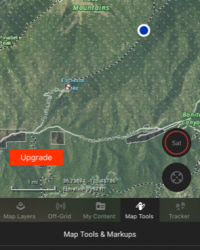
WHY A HIGHLINE OR PICKETLINE
For years the US Forest Service and others have discouraged tying animals to trees. The destruction to the tree and the root system being their main concern. While the safety and well being of the forest should be very important to you the safety and well being of your pack mule is of paramount importance and if you tie to a tree you are putting you animal in jeopardy. Pack mules will roll and if tied off to a tree can be seriously injured. It is also easier for these animals to break a lead rope, snap, or halter if they are tied to a solid object. A high-line or picket-line if properly installed will allow your pack mules and horses the ability to eat, lay down, and roll with no hassle. The high-line will also give safety and security to your pack mules and horses while being close to impossible to break because of the flex in the line. What is a high-line? It is simply a non-stretch rope tied between two set points, usually trees, about seven feet off the ground. Evenly spaced out are tie offs or prusik loops (with swivels) where you would use a slip hitch bowline to tie off your pack mule or horse. The best practice is to tie them where they need to pull the high-line down a few inches to reach the ground. This way they do not have enough slack to get a leg caught in the lead rope. One very important part of a high-line is the order in which the pack mules are lined up on the high-line. Be mindful of the peck order when you put them on the high-line do not put the bully next to the sissy if you want any peace on your pack trip.
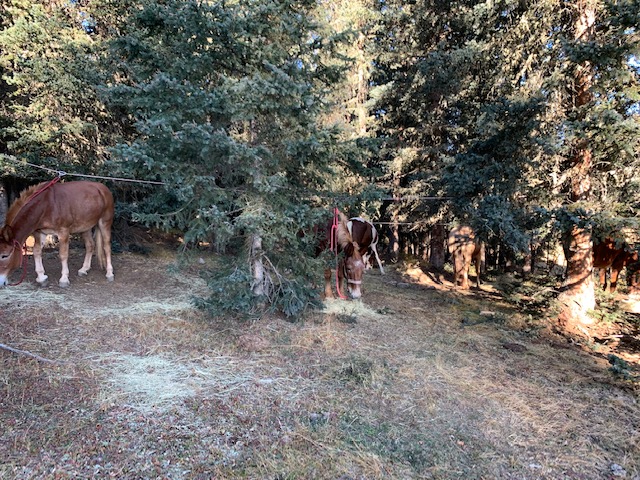
MULES ON HIGHLINE IN NEW MEXICO (FRONT LEFT BELLA, FRONT RIGHT FESTUS, PAINT IN THE BACK IS JACKSON)
IN MY OPINION HIGHLINE IS THE BEST WAY TO TIE YOUR PACK MULES AND HORSES FOR ANY EXTENDED TIME.
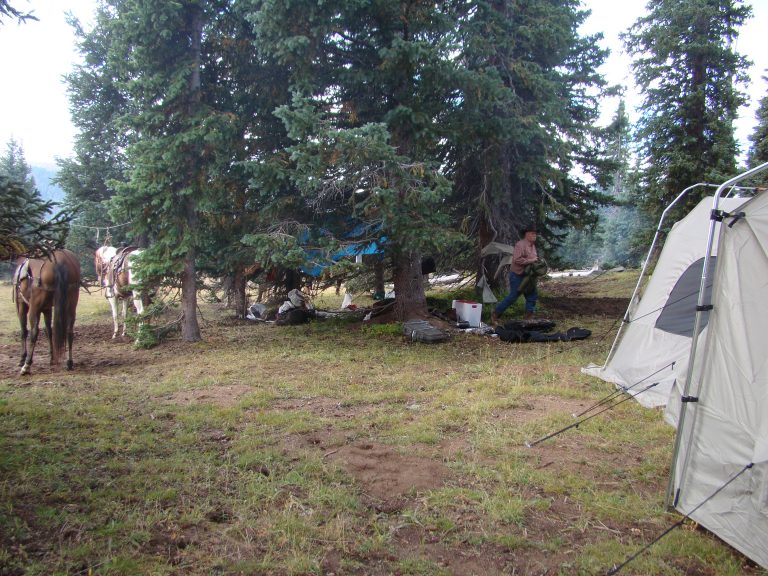
THE HIGHLINE IS CLOSE ENOUGH TO HEAR WHAT’S GOING ON BUT NOT SO CLOSE THAT IF SOME KIND OF WRECK HAPPENS WITH THE MULES OR HORSES YOUR NOT IN DANGER OF LOSING THE TENT.
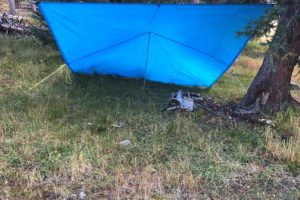
THE STARTING OF A TACK ROOM
Set up your tent close but not extremely close to the mules usually around sixty to a hundred feet. This is because you want to be able to hear the commotion when (not if) there is one but not be in it. When camp is set up we begin work on the tack room which is usually not a room at all but a place where we keep all the saddles, saddle pads and usually the feed. The best idea here is to use a longer tarp and lay it on the ground. Then you place all the gear on one side, take the other side and build a watershed with it. There are many ways to do this with the main idea being to keep your gear and feed as dry as possible. In some locations you will not have trees to help make a watershed and will just have to put the tarp over your tack. Once the tent and tack are up and running it’s time to water the horses from the big ride. General rule on feeding or watering the pack mules and horses, always leave a rideable mule or horse tied up while you water or graze. This should be self-evident but if the mules run off you have a mule or horse left to saddle up and gather them. The other benefit that may not be as evident is that the startled stock may run back to the animals tied up because they feel comfortable with their company. Quick story, we are in the mountains in New Mexico getting ready to head out on the trail. Bella one of our pack mules was a little uneasy about the whole trip this part of the mountain was a popular ATV area. The added noise of the off-road vehicles made her nervous and something in the panniers was not sitting well with her. When we put the last pannier on her she started bucking, pulled loose, and was gone. We started collecting all the items that had been bucked out and before we could get to many things picked up Bella came running back and went directly to the high line and stood by Festus (her buddy). In this case having Festus tied up saved us hours maybe even days of tracking down Bella. Usually we just divide the animals in half and take one half at a time just make sure the half left behind has a rider or two so you can track down any that run off.
Once camp is setup and ready it is time to water the string. When watering your pack mules try to find a hard surface they can approach the water from. Its hard on them to wade through a marsh each time they want a drink. No pack mule or horse is created equal when it comes to drinking in the mountains. Over the years I have seen some pack mules that would drink at every chance and some that you think how are they still alive. Mules are of coarse a mix between a horse and a donkey and have traits of both. The donkey originates from an arid climate where water supplies were scarce and, as a result, evolved into an animal that can get by on very little water. Not to say they don’t need water but they can get by on less than one would think. Mules tend to drink only what is needed to replenish loss a horse on the other hand will drink until it becomes ill. We have been on two-day trips where a mule will not take a single drink and the mule never became compacted or had any other dehydration related trouble. I would say two days is the longest I have seen a pack mule not drink. Horses usually drink within the first day. Once everyone has had a nice long drink take the animals back to the highline.
When watering is done we feed the pack mules and horses. We use feed bags they are very easy to pack and lite weight. Some take canvas buckets for feeding the animals. Feed bags may take a bit of training so make sure you try this method before you are at camp ten miles from the trail head. We have never had trouble with feed bags once they figure out that food is in the bag. The feed in the mountain is the same grain as back at the farm. I have overheard some talk at the trailhead of people using higher protein grain in the mountains but I don’t think this is a good idea. Pack mules can founder on grain that is to high in protein. Most horse rations are around 16% protein, and in reality, a little high for mules, pack mules tend to do better on a 10-12% protein grain. Pound for pound a pack mule will eat less than a horse as a general rule. Sometimes one-third the amount of a horse the same size and doing the same labor. It is rare that a pack mule will eat to the point of colic. A small salt block should be thrown in on trips lasting more than five or six days. If you have a pack mule that is chewing up ropes and other things this can be a sign of a salt-starved animal.
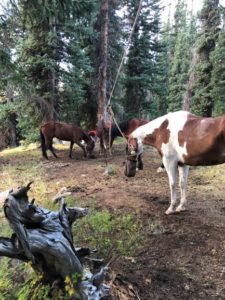
WHY FEED BAGS
Feed bags are a simple system that has been around for along time. They are bags that go on the face of your pack mule or horse that hold the feed. The pack mule or horse simply puts it on the ground to reach the food. We like them for a few reasons. One, you really cut down on waste, the feed will not fall out of the bag that easy and the animal can not step in it or knock it over. Two, is ease of use for the person feeding. Simply fill the feed bags all at once and carry them over to the pack string and place them on the mule or horse. when done take them off. No buckets to chase down or carry one by one to the mules. We have used them for years and have not ran into a mule or horse that would not take to one especially after they realize what is inside.
We generally do not graze the mules on the first day. We graze twice a day after that for about 30 minutes each time. Grazing can be done many ways. We typically walk the animals to the grazing area and hold the lead while they graze. Several outfitter and packers hobble their pack mules and turn them out to graze. They will put a bell on one or two so they can track their whereabouts. The other commonly used method is portable electric fences. Portable electric fence packages can be bought with several hundred feet of wire tape, poles, charger, solar panel, and all the clips needed to make a small enclosure. I talked with guys that used this method for so long that the pack mules and horses have been trained to stay away from the wire and they no longer take the charger or panel. They also asked me to keep that quite so their mules don’t hear about it so please don’t tell. All joking aside, it can be a very useful way to graze pack mules and horses so you don’t have to stand with them the entire time. After grazing is done depending on the location of water we will take them to water and let them get a good long drink. When all the animals are secure, fed, and watered then you can relax and enjoy your time in the mountains. Each day the pack mules and horses should be grazed, watered, and fed twice a day.


